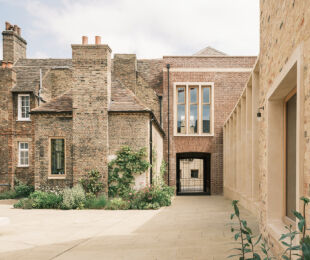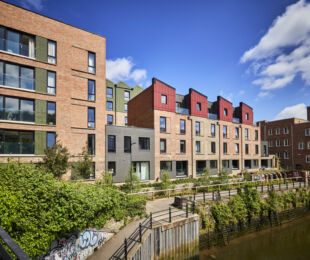
A redundant 1930’s brick-built neoclassical electricity substation in Camden, north London, has been repurposed as apartments by architect Studio 54. By the 1950s the building was no longer required by the local network and Camden Council acquired it for use as a sports centre. In 2010 it was deemed superfluous to requirements and sold to property group A2 Dominion/Kingsbury with support for a change-of-use to residential.
The former substation, at 142-150 Arlington Road in the Camden Town Conservation Area, was considered worthy of retention. The main west elevation on Arlington Road featured windows that opened to the original turbine hall, while the south and east facades were largely windowless. The building filled the site, with no external spaces. Studio 54’s key challenge was to integrate the retained facade with the new residential requirements, which included new floors, windows and external terraces and balconies.
The two principal facades were retained and the rear facade replaced with a new brick structure, and five new floors built, with a setback floor above the existing parapet. The floor heights were adjusted to correspond to the pattern of openings facing Arlington Road, with cills lowered and a central entrance formed. The window frames were replaced in a style that reflects the character of the retained facade. The lift, stairs and corridors are in the centre of the plan and the apartments include a mix of flats and duplex units, some single-aspect, some dual-aspect. At the third floor onto Arlington Road the apartments are set back to create terraces. At the back of the building onto Stanmore Place, the existing corner bay is retained, but the rest of the facade has been replaced by a new stepped plan and section which provides daylight into the deep-plan, set-back entrances, terraces and balconies and an active frontage.
New doors and window openings are generously sized and the recessed plan is clad in white brick, mitred to the stock brick, which forms the outer facade. The affordable accommodation comprises larger units accessed from Stanmore Place, and the for-sale units are located on the ground and upper floors with access from the Arlington Road entrance.
For the architects, the project felt like an object lesson in understanding the tensions that characterise development in inner-city areas. It was a protected building in a conservation area that has outlived both its original function and a later change-of-use; the council finance department was keen to generate funds to support under-resourced local services and therefore determined to squeeze everything possible out of the site sale; the housing market promised riches for the right development in the right location; the planning department was determined to protect this ‘historic asset’ and to obtain the regulation quantity of ‘affordable housing’ funded out of the ‘for sale’ units; and the site came loaded with problems that could compromise a viable housing development, with a protected facade with few windows, a very deep plan, a cavernous interior and no external space.
“The project celebrates and enhances the facades of the original neoclassical industrial building while juxtaposing a contextual contemporary architecture, sensitive to the original with a bespoke design language that is functional and disciplined as well as being optimistic, informal and in areas boldly sculptural. The project enhances the Conservation Area and brings life and activity to a corner of Camden that has been sidelined and run down for decades”, says Studio 54.






